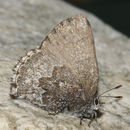ar
الأسماء في صفحات التنقل


Callophrys fotis is a species of butterfly in the family Lycaenidae, the gossamer-winged butterflies. It is known by several common names, including early elfin, desert elfin, Fotis hairstreak, Strecker's elfin, and Arizona gray elfin.[1] It is native to the southwestern United States, where it occurs in southeastern California, Nevada, Utah, western Colorado, northern Arizona, and northwestern New Mexico.[1]
This butterfly has a wingspan of 19 to 28 millimeters. It is gray on the upperside and brownish gray on the underside. The hindwing has a darker base and a grayish to yellow-gray tip.[2]
This species occurs in desert habitat, especially pinyon-juniper woodland. Its host plants are Stansbury's cliffrose (Purshia stansburiana) and related species. Males perch on the plants awaiting females, which then deposit eggs on the flower buds. The caterpillars feed on the flowers and developing fruits and pupate over the winter in the litter beneath the plant. Adults fly from March through May.[1]
Subspecies include:[3]
Callophrys fotis is a species of butterfly in the family Lycaenidae, the gossamer-winged butterflies. It is known by several common names, including early elfin, desert elfin, Fotis hairstreak, Strecker's elfin, and Arizona gray elfin. It is native to the southwestern United States, where it occurs in southeastern California, Nevada, Utah, western Colorado, northern Arizona, and northwestern New Mexico.
This butterfly has a wingspan of 19 to 28 millimeters. It is gray on the upperside and brownish gray on the underside. The hindwing has a darker base and a grayish to yellow-gray tip.
This species occurs in desert habitat, especially pinyon-juniper woodland. Its host plants are Stansbury's cliffrose (Purshia stansburiana) and related species. Males perch on the plants awaiting females, which then deposit eggs on the flower buds. The caterpillars feed on the flowers and developing fruits and pupate over the winter in the litter beneath the plant. Adults fly from March through May.
Callophrys fotis is een vlinder uit de familie van de Lycaenidae.[1] De wetenschappelijke naam van de soort is voor het eerst geldig gepubliceerd in 1877 door Strecker.
Bronnen, noten en/of referenties